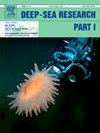Origin and propagation of M2 internal tides in the Arabian Sea
IF 2.1
3区 地球科学
Q2 OCEANOGRAPHY
Deep-Sea Research Part I-Oceanographic Research Papers
Pub Date : 2025-02-01
DOI:10.1016/j.dsr.2024.104441
引用次数: 0
Abstract
Internal tides (ITs) generated by the interaction of barotropic tides and rough topography in stratified oceans play a significant role in turbulent mixing and thermohaline circulation. The baroclinic modes, propagation, energy, and origin of M2 ITs in the Arabian Sea are analyzed using Multivariate Inversion of Ocean Surface Topography Internal Tide Model product (MIOST-IT). The M2 ITs are generated in the northeast Arabian Sea, around the Socotra Island, and around the Maldive Islands, dominated by the mode-1 component with a wavelength of approximately 110 km. The most energetic M2 ITs radiate from the continental shelf of the northeast Arabian Sea for more than one thousand kilometers with mode-1 and mode-2 energy of approximately 0.56 GW and 0.04 GW, respectively. M2 ITs generated around the ridges southeast of the Gulf of Oman propagate southeastward, whereas they radiate in all directions from the Socotra Island. The northeastward-propagated M2 ITs from the Socotra Island and the southwestward-propagated M2 ITs from the continental shelf form standing waves. The M2 ITs propagate westward on the western side of the Maldive Islands and eastward on the eastern side, dominated by mode-1 with energy of 0.17 GW and 0.08 GW, respectively. The study presents the characteristics of multi-directionally propagated and multi-modally M2 ITs in the Arabian Sea, which addresses the characteristics of M2 ITs in the region, therefore contributing to the understanding of the Arabian Sea's role in regional and global overturning circulation, energy budget, climate dynamics, and ecological environments.
阿拉伯海M2内潮的起源和传播
在层状海洋中,正压潮汐与粗糙地形相互作用产生的内潮在湍流混合和温盐环流中起着重要作用。利用multimultivariate Inversion of Ocean Surface地形内潮模式产品(MIOST-IT)分析了阿拉伯海M2 ITs的斜压模态、传播、能量和来源。M2 ITs产生于阿拉伯海东北部、索科特拉岛周围和马尔代夫群岛周围,由波长约为110 km的1型分量主导。能量最大的M2 ITs从阿拉伯海东北部大陆架辐射一千多公里,模式1和模式2能量分别约为0.56 GW和0.04 GW。M2 ITs产生于阿曼湾东南脊附近,向东南方向传播,而从索科特拉岛向四面八方辐射。从索科特拉岛向东北方向传播的M2 ITs和从大陆架向西南方向传播的M2 ITs形成驻波。M2 ITs在马尔代夫群岛西侧向西传播,东侧向东传播,以模式1为主,能量分别为0.17 GW和0.08 GW。本研究揭示了阿拉伯海M2 ITs的多向传播和多模态特征,揭示了该区域M2 ITs的特征,有助于认识阿拉伯海在区域和全球翻转环流、能量收支、气候动力学和生态环境中的作用。
本文章由计算机程序翻译,如有差异,请以英文原文为准。
求助全文
约1分钟内获得全文
求助全文
来源期刊
CiteScore
4.60
自引率
4.20%
发文量
144
审稿时长
18.3 weeks
期刊介绍:
Deep-Sea Research Part I: Oceanographic Research Papers is devoted to the publication of the results of original scientific research, including theoretical work of evident oceanographic applicability; and the solution of instrumental or methodological problems with evidence of successful use. The journal is distinguished by its interdisciplinary nature and its breadth, covering the geological, physical, chemical and biological aspects of the ocean and its boundaries with the sea floor and the atmosphere. In addition to regular "Research Papers" and "Instruments and Methods" papers, briefer communications may be published as "Notes". Supplemental matter, such as extensive data tables or graphs and multimedia content, may be published as electronic appendices.

 求助内容:
求助内容: 应助结果提醒方式:
应助结果提醒方式:


